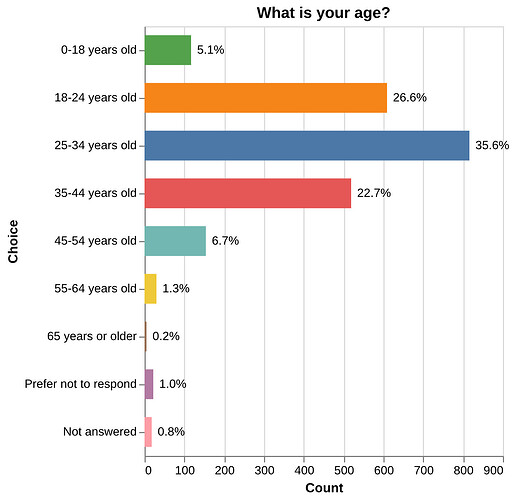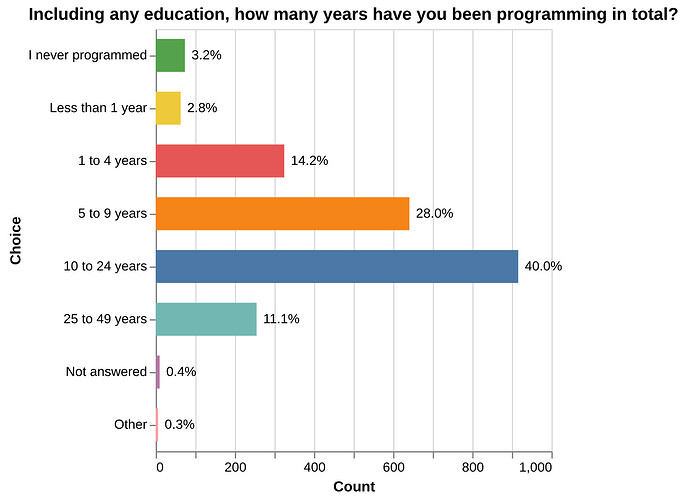2024 Nix Survey Results
Hello, fellow Nixers! It’s that time of year again!
Like many of you, I’ve noticed that the Nix community is growing steadily. Now, more than ever, we’re eager to understand what our community looks like. Who makes up the Nix community? What tools do we use? How do we navigate the Nix ecosystem? And most importantly, what do we care about?
The Nix Survey, which began a few years ago, has become our annual tradition for gaining insight into these questions. Your responses provide crucial data that Nix teams, contributors, and community members rely on to shape the future of Nix!
tl;dr
- Thousands of answers are amazingly many. It is incredible how hundreds of people care about the system and take the time to fill in the survey! Interestingly, half of respondents are new users who started using Nix within the past year.
- Nearly all respondents use NixOS, solidifying its central role in the Nix ecosystem. Interestingly, only about half of respondents use Nix for software development.
- Most users rely on the search functionality (for packages and NixOS options) in their workflow, while the Wiki and the official manual are the go-to sources for help. GitHub issues and source code also remain popular resources.
- Respondents want to engage with Nix’s roadmap.
Previous announcements and results
- Nix Community Survey 2024
- Nix Community Survey 2023 - Nix Community Survey 2023 Results
- NixOS Community Survey 2022 - 2022 Nix Survey Results
Total Participation and Response Rate
We received 2,290 full responses this year, marking a 30% increase compared to last year!
Engagement across individual questions was impressively high, with a response rate nearing 97%. This reinforces our efforts to make the survey more streamlined by reducing open-ended text questions in favor of clearer, single-choice options.
Note
For many questions, respondents could select multiple choices. In those cases, the data is displayed using stacked bar charts, where the added percentages of the “Selected” / “Not selected” options sums to 100% on a single choice.
Single-choice questions are displayed using standard bar charts, where the total percentage adds up to 100%.
The Shape of the Nix Community
Respondents primarily hail from Europe (52%) and North America (27.5%), a distribution consistent with last year’s results.
In terms of gender identity, the majority of respondents identify as men (84%). Percentages between those who preferred not to answer (5%) or identified as women (5%) or non-binary (also around 5%) were too close to draw any conclusion.
Nearly all respondents (99%) are GNU/Linux users. Interestingly, 37% also use Windows, which surpasses the 28% who use macOS. On mobile, Android leads with 55% of respondents, compared to 20% using iOS.
This year, we shifted the question about main occupations from multiple-choice to single-choice, and the results were similar to last year. The majority of respondents are full-stack developers (20%), followed by backend developers (14%), with a significant portion of students (19%).
When it comes to programming experience, the data shows a strong bias toward seasoned developers: 52% of respondents have been programming for over 10 years, and only 3% have never programmed. It’s clear that Nix primarily attracts users with considerable programming experience.
Overall, the “shape” of our community remains largely consistent with previous years.
The learning journey, NixOS wins and YouTube fame
39% of respondent have been using Nix for less than a year. This is really cool, because it means newcomers care about Nix/NixOS and are willing to engage with the ecosystem! At the same time, it means that the survey results are biased towards this population. For instance, about as many respondents (41%) describe their Nix skill level as “Beginner”.
Actually, by crossing answers to both of these questions, we can uncover what the Nix/NixOS journey looks like. Respondents who have joined this year feel like beginners for the most part, which is fair. That being said, a good portion of respondent who have joined this year describe themselves as intermediate users, which is interesting. Then, most respondents with 1 to 2 years of Nix experience feel intermediate. Sadly, a non neglectable proportion of respondents with 1 to 2 years of experience describe themselves as beginner. Then, interestingly, there seem to be a plateau, where respondents tend to keep describing themselves as intermediate users below 5 years of experience. Then, after 5 years of experience, some of them describe themselves as advanced.
This could be a hint at what the Nix/NixOS journey looks like on average: 1 year to ramp up, then 3~5 years to mastery.
NixOS is used by 9 out of 10 respondents. That is big!
Though, only 74% of people use Nix to install software, which is surprising since once would expect NixOS users to also use Nix at least to install packages. Could it mean that 16% of NixOS users among respondents only ever install software via their NixOS configuration?
But wait, there is more! When crossing both questions “How many years have you been using Nix in total?” and “Which of these best describe your involvement with the Nix ecosystem? I use NixOS: Yes/No?”, to our surprise about 90% of Nix users also use NixOS, no matter how long they’ve been using Nix. More specifically, even Nix users who have been using Nix for less than a year also use NixOS. This could be indicative that newcomers either discover Nix via NixOS or onboard NixOS fairly quickly. A more detailed questionnaire would be need to know that. This seems to be validated by the answers to “Did you hear about Nix or NixOS first?” to which 71% responded “NixOS”.
Another unexpected result: the biggest medium from which respondent have found about Nix is now YouTube (23%), more than the usual word-to-mouth from a friend (18%) who probably said “I use NixOS, btw”. ![]()
Again, crossing with years of experience of Nix shows that it is mostly respondents who have used Nix for less than a year that have heard about it from YouTube. Is NixOS on the path to becoming mainstream? ![]()
Using Nix
Respondents mostly love the idea behind Nix (87%), which shows that its adoption comes from its groundbreaking ideas.
But also, half of respondents use Nix to get things Nix (52%). We all know that “It just works™” adage by now.
Almost all respondents use Nix on Linux (94%), and a good proportion also use it on macOS (22%). Like last year, about 10% of respondents use Nix on Windows via WSL.
But how do people install Nix? The official installer is still at the top (32%) if we exclude NixOS (89%), but it’s worth noting that many respondents have used the DeterminateSystems Nix installer (21%).
As expected, most respondents use Nix on a personal computer (95%) and/or home server (55%). But also, Nix is used in production! (19%)
Respondents use mostly the 2.18. A non-neglectable proportion of respondents use Lix.
Respondents use mostly either the unstable channel (65%) or 24.05 (60%), way above any other channel. Given that many respondents are newcomers, it will be interesting to track if they update to a more recent channel next year as well.
When it comes to programming, the top “programming ecosystem” used is NixOS configuration (83%), which is not surprising considering that everyone has to write their own, and one can tend to easily customize it. I think, however, that the choice was misunderstood, as a lot of respondent most likely thought we meant “using NixOS configuration modules” and not “creating NixOS configuration modules”.
Otherwise, Python is at the top (49%), then Bash (46%) and Rust (44%). C, JavaScript, Go and C++ follow (around 24%).
Without much surprise, the flakes experimental feature is widely used (85%) among respondents, as well as the nix-command one (69%).
Navigating Nix
Respondents say they interact most with the Package Search and NixOS option search (top 2 of rank 1 and 2). It shows how essential these tools are to Nix users!
When it comes to getting help, they mostly rely on the official NixOS Wiki, the Reference Manual, as well the the source code (top 3 of rank 1 and 2, and top 4 of rank 3 and 4).
We can be proud as a community: respondent most often find the help they need!
Results
Below are all the quantitative results.
You can download all aggregated data here: nix-survey-results-2024-11-02.zip - Google Drive
Method
The Nix Marketing Team conducted an online survey of 27 questions, of which 11 were single choice questions, 10 multiple choices, 2 ranking and 4 open-ended.
Questions were designed through PRs at GitHub - GuillaumeDesforges/nix-survey: Documentation and assets for the Nix Community Survey and conversations on the team’s Matrix channel.
The survey was open for a two months period from July 22th until September 16th. We announced the survey by way of postings to Nix Discourse, Matrix, LinkedIn, Twitter and Reddit.
Once the survey was closed we split the analysis into two: multiple choice questions and open-ended questions. Single and multiple choices questions were analyzed numerically by compiling the responses by count and percentages, and comparing to previous year’s results. Open-ended questions were analyzed by manually reviewing the responses. The survey analysis was conducted throughout the month of October. Code of the analysis is available at GitHub - GuillaumeDesforges/nix-survey-analysis-2024: Analyze Nix Survey 2024.
About governance questions
The most recurrent feedback by respondents was the perceived lack of questions about governance.
We understand this feedback, which was to be anticipated.
The design phase of the survey happened at an early stage of the discussions about governance, and our team are facilitators who help the community - often Nix team members, though it is not restricted to them - design questions openly through PRs and discussions in the Matrix channel.
Our team hopes that, for the next edition, questions on the topic of governance will be designed to best serve the Nix community and its governance.
Final words
Huge thanks to all the people who contributed to the survey: @fricklerhandwerk @ron @Arsleust @DanielSidhion @thufschmitt @djacu @tomberek
Special mention to @fricklerhandwerk who took the time to go through thousands of free-text answers, taking hours to carefully review them and provide useful aggregated insights!
If you’d like to help organize next year’s survey please join our Matrix channel: #survey:nixos.org
See you next year!








































